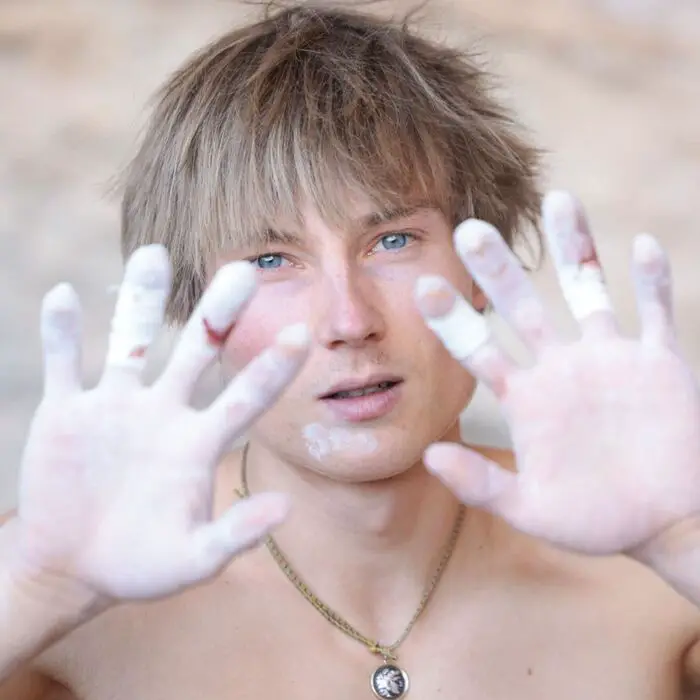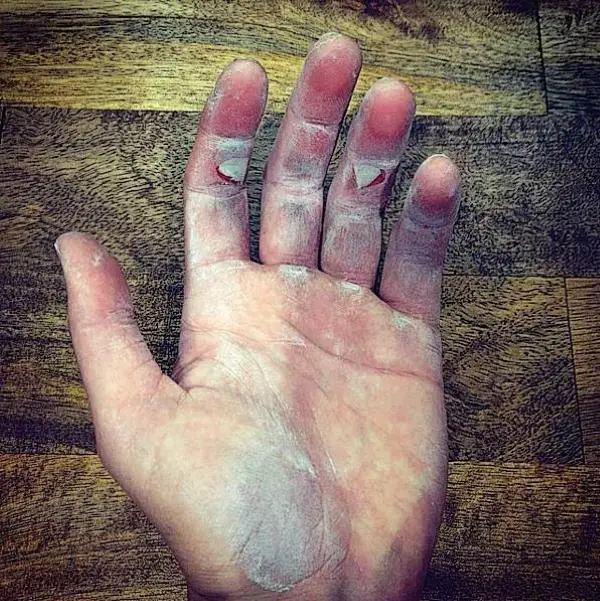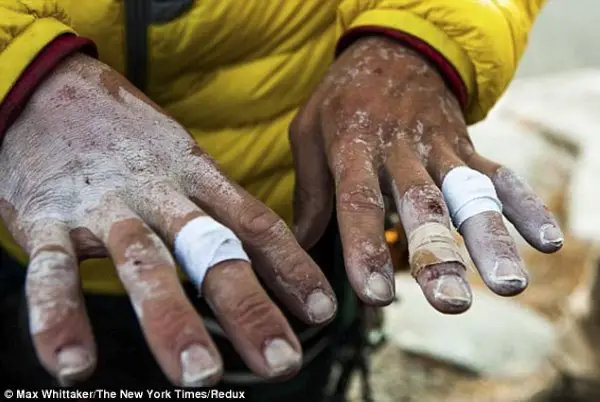The world of rock climbing is most definitely dangerous and filled with danger lurking at every corner. You have your Elvis foot, your flash pumps, muscle cramps, and a sore neck from belaying too much. Out of this glossary of horrors, today we’re going to talk about the enemy of the climber, that one small injury that might even compromise your climbing day – the flapper.
Why is this flapper such a pain? Because once you get it, without proper care, your day at the crag will not be as pleasant as before.
The good news is that today we’re not only going to talk about flappers and rock climbing blisters but also how to take care of one of the climber’s most important assets – the skin.

What Is A Climbing Flapper?
A rock climbing flapper is a piece of skin that has been torn off and is hanging by only one edge. Usually, these happen below your fingers, on your phalanges, and even on your knuckles in some peculiar cases. They vary in shape and size, but one thing is for sure, they sting like there’s no tomorrow.

Flappers usually occur as a result of climbing blisters or torn calluses. Some people believe that even if you pop a blister, you can end up having a flapper. But truth be told, you’ll maybe get one out of negligence or lack of knowledge because beginners tend to develop more compared to experienced climbers who have thick rhino skin.
Climbing flappers will more commonly appear when you are climbing indoor. The tough texture of artificial climbing holds are really rough on the skin and can cause flappers pretty quickly. Outdoors, it’s not as common to get flappers as the rock isn’t like sandpaper on your skin.
What’s The Treatment For A Climbing Flapper?
Well, you got too sendy on that boulder problem and ended up having a flapper. What now? Can you still save your skin and send it? The answer is maybe, considering your pain tolerance. While a flapper problem can mean the end of the day for newbies, more experienced climbers can carry on a bit longer.

Here is what you should do if you get a flapper.
1) Wash Your Hands
A flapper is a wound so treat it like you would treat any other wound. First and foremost, wash your hands with water and soap, and clean off all that dirt and chalk. If you don’t have access to soap, just run some cold water over the flappers.
Do not, I repeat, do not use hand sanitizer. Unless you want the whole crag to hear your cries.
2) Give Your Flapper Some TLC
If you want to carry on with your climbing, it’s best to apply some cream and close the flapper back in place before taping it. This way, your skin will stay moist, and you won’t have that stingy feeling when grabbing a jug. Some other folks recommend that you trim, not rip off, the loose skin using a pair of scissors, nail clippers, or some very careful climbers even use a shaving blade. After you’re done with “flapper surgery”, apply some antiseptic cream and some tape over the flapper.
3) Let Your Skin Breathe
Taping up your fingers is fine if you want to continue climbing. Once you get home though, make sure you take the tape off, wash your hands thoroughly and apply some more cream if needed.
The air will help dry out the wound a lot faster, so try to not keep your fingers or palm taped up for longer than necessary.
How To Tape Fingers For Climbing Blisters
Taping your fingers for climbing blisters is easy once you get the right technique. Just make sure you keep your joints free as you’ll need to maintain full mobility.

How you apply tape will depend on where the flapper is. If it’s on your fingers, you’ll want to tape around the flapper. If the flappers are below the fingers, you have to mummify your hand completely, meaning you’ll need to wrap the tape around your hand and in between your fingers to keep the tape stable.
Again, if you don’t want to scream and cry, place a small piece of gauze or double-up tape on your flapper before you tape it.
Another thing that some climbers resort to is gluing up the flapper. Do not try this with super-glue, as it contains cyanide, but you can find some medical glue for this. Personally, I would just let your wound heal on its own without applying things like glue.
How To Prevent Climbing Flappers
Although sooner or later you’ll end up with a flapper, they can be prevented, for the most part. Be really careful with your skin, listen to your body, and take your time. Your project will still be there the next day or next week, so avoid punishing your skin.
1) Take Care Of Your Calluses
Even if they’re not so aesthetically pleasing, calluses are among a climber’s best friends, and you should always take care of them. Keep them flat and smooth by using a skin file or a pumice stone; some hardcore rock climbers even end up using sandpaper. Be careful not to file your calluses too much because you’ll need these babies.
2) Keep Your Skin Hydrated
Hydrated skin is happy skin. Wonder why? Because when you apply moisturizer, your skin becomes more elastic, and thus you reduce the risk of tearing it. More than that, hydrated skin doesn’t crack or peel, so it’s less likely to turn into a flapper or blister.
3) Don’t Over Do It
Your skin wears out as you climb longer and harder so keep an eye on it between climbs. You’ll instantly know when you’ve got a blister or flapper forming. Start easy, but don’t keep climbing past sore fingers and hands. You’re better off stopping before the flapper. That way, you’ll only need to rest for a day as opposed to a few if you had a nasty flapper that needed to be healed.
4) Hot Water Is The Enemy
What do flappers and blisters hate the most? Those dreamy hot showers you take after a long session at your freezing gym. Interestingly enough, long hot showers actually dehydrate your skin. So avoid steamy showers for a few days.
5) Bonus Tip!
Are you training for a project? Toby Roberts gave an awesome tip in one of his recent YouTube videos on what to do when training for a project or in his case, the competitions. If you want to have perfect skin for sending your project, tape all your fingers up when you are training. This way, you’ll be climbing on tape and when it comes to send hard, your skin will be fresh.
Here are Tom Randall and Josh Hadley from Lattice Training showing us how to take better care of our skin.

FAQs
.


